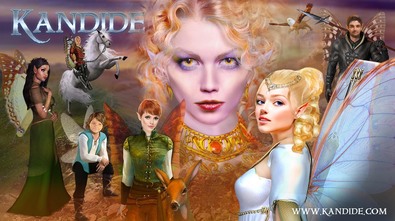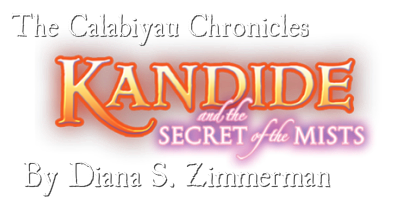
So many people have asked me about the meanings embedded in Kandide. I have always loved faeries, and wanted to create a world that is as magical as the one I loved as a child, but more mature. Here is a brief overview.
Faeryland’s Disruptive New World
“As decisively disruptive as it is deliciously irresistible.”
The Kandide books unleash a decisively disruptive view of a land we all grew up loving—Faeryland. Blazing undertones of ancient philosophy clash with elitist societal manipulation to create a world far more like our own than some would care to admit.
No longer the fanciful kingdom of our childhood, Kandide’s world—set in the enigmatic land of Calabiyau—is a haven for treachery, dark magic, intrigue, deceit, bigotry, and political cunning, melded with an unrelenting struggle to reawaken kindness, beauty, personal freedom, and social acceptance.
It’s a land obsessed with power, parties, beauty, and adventure—where magic is as normal as the sunrise; time passes differently; sunsets last for hours; waterfalls flow uphill; hideous, as well as exotically beautiful beasts, roam the forests; and everyone can fly. A land where physical perfection is essential, and “Imperfects”—those who aren’t physically perfect—are sent to a savage dead-land deep within the Mists.
Throughout the series, the very personal struggles of Kandide—the Fée teen-queen who rules Calabiyau—continually commandeers our emotions. Love her or hate her, you will do both. Not only must Kandide battle those in her Royal Court whose evil sorcery continually betrays her, but her own conflicted sense of vanity, derived from a deep-seated lack of self-esteem. All of which gets worse after she is injured and becomes an Imperfect—the very thing she abhors the most.
When summing up Kandide, perhaps a quote from Walt Disney says it best: “We don't actually make films for children. We make films that children can enjoy with their parents.” The Kandide series is no different. It’s not written for children. It’s a series children love—as do their parents. Which is certainly why the stories have a steadily growing fan-base among 18 to 35 year-old Millennials, as well as tweens and teens, and, curiously, men of all ages. Each demographic group, regardless of age or gender, is able to apply a highly personal and progressively deeper meaning to the finely laced values contained within the pages.
The books’ flurry of quotable moments further question what we know. Queen Tiyana’s statement that: “At times, we all wear masks of deception. Some are for evil. Others are for good,” challenges the very concept of how we perceive deceit. Lord Rössi, a member of Kandide’s High Council, juxtaposes the boundaries of what we assume to be true: “The difference between science and magic is that magic always works. Science is yet unfolding.” Or Egan’s question, “Why do some people need to make themselves feel good by making other people feel bad?” gets the heart of bullying. These are just a few of the contradictions that challenge each reader’s thinking, regardless of his or her age.
Whatever your personal beliefs, the story of Kandide—her spoiled nature, her growth, her forced reassessment of a pampered and elitist life-style, combined with the glamour, the adventure, the intrigue, the battles, and the vile dark magic she and her family continually face—will transport you into an otherworld that is as “decisively disruptive as it is deliciously irresistible.”
“As decisively disruptive as it is deliciously irresistible.”
The Kandide books unleash a decisively disruptive view of a land we all grew up loving—Faeryland. Blazing undertones of ancient philosophy clash with elitist societal manipulation to create a world far more like our own than some would care to admit.
No longer the fanciful kingdom of our childhood, Kandide’s world—set in the enigmatic land of Calabiyau—is a haven for treachery, dark magic, intrigue, deceit, bigotry, and political cunning, melded with an unrelenting struggle to reawaken kindness, beauty, personal freedom, and social acceptance.
It’s a land obsessed with power, parties, beauty, and adventure—where magic is as normal as the sunrise; time passes differently; sunsets last for hours; waterfalls flow uphill; hideous, as well as exotically beautiful beasts, roam the forests; and everyone can fly. A land where physical perfection is essential, and “Imperfects”—those who aren’t physically perfect—are sent to a savage dead-land deep within the Mists.
Throughout the series, the very personal struggles of Kandide—the Fée teen-queen who rules Calabiyau—continually commandeers our emotions. Love her or hate her, you will do both. Not only must Kandide battle those in her Royal Court whose evil sorcery continually betrays her, but her own conflicted sense of vanity, derived from a deep-seated lack of self-esteem. All of which gets worse after she is injured and becomes an Imperfect—the very thing she abhors the most.
When summing up Kandide, perhaps a quote from Walt Disney says it best: “We don't actually make films for children. We make films that children can enjoy with their parents.” The Kandide series is no different. It’s not written for children. It’s a series children love—as do their parents. Which is certainly why the stories have a steadily growing fan-base among 18 to 35 year-old Millennials, as well as tweens and teens, and, curiously, men of all ages. Each demographic group, regardless of age or gender, is able to apply a highly personal and progressively deeper meaning to the finely laced values contained within the pages.
The books’ flurry of quotable moments further question what we know. Queen Tiyana’s statement that: “At times, we all wear masks of deception. Some are for evil. Others are for good,” challenges the very concept of how we perceive deceit. Lord Rössi, a member of Kandide’s High Council, juxtaposes the boundaries of what we assume to be true: “The difference between science and magic is that magic always works. Science is yet unfolding.” Or Egan’s question, “Why do some people need to make themselves feel good by making other people feel bad?” gets the heart of bullying. These are just a few of the contradictions that challenge each reader’s thinking, regardless of his or her age.
Whatever your personal beliefs, the story of Kandide—her spoiled nature, her growth, her forced reassessment of a pampered and elitist life-style, combined with the glamour, the adventure, the intrigue, the battles, and the vile dark magic she and her family continually face—will transport you into an otherworld that is as “decisively disruptive as it is deliciously irresistible.”

 RSS Feed
RSS Feed